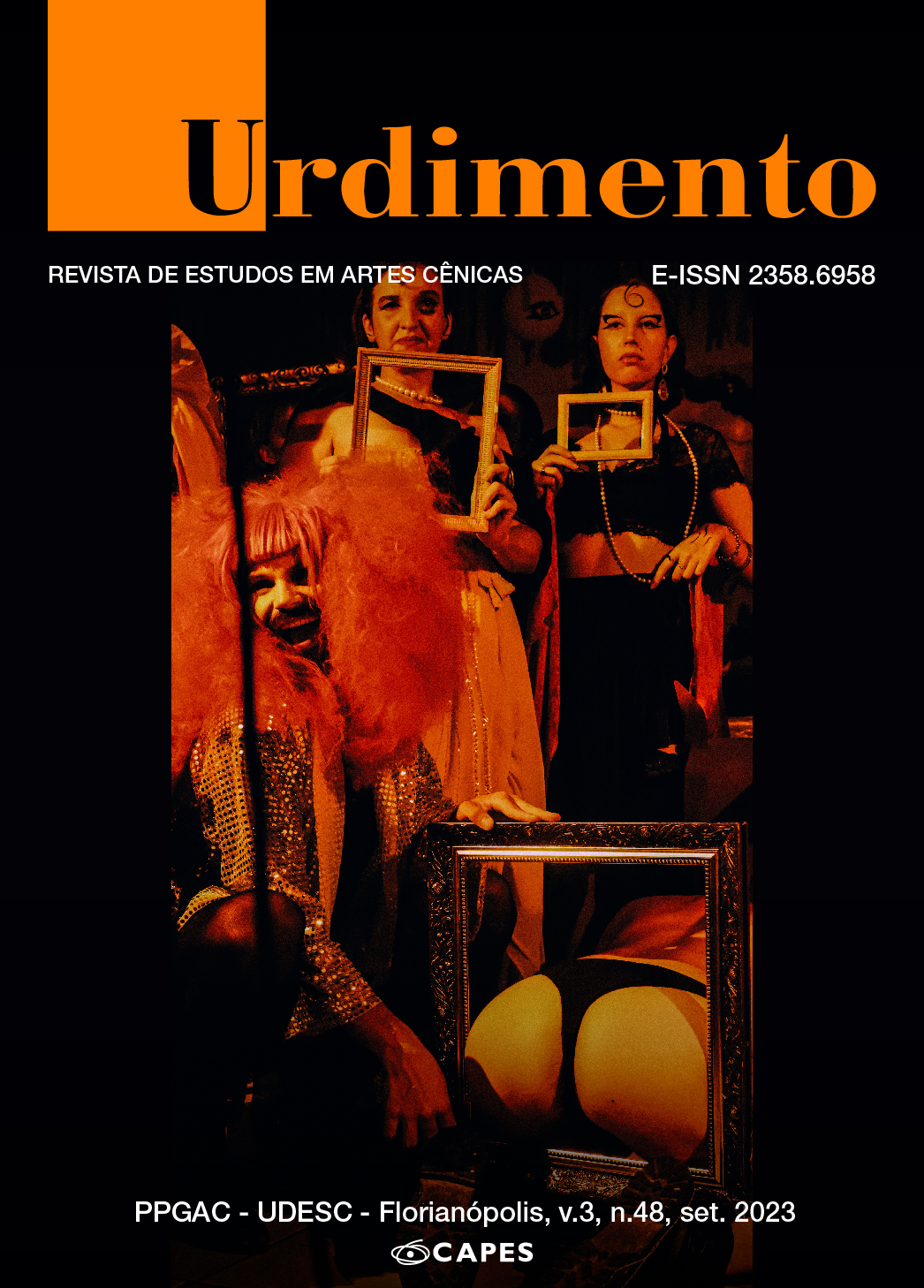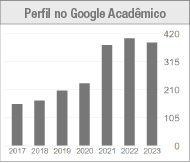Engajamento do público e agenciamento espacial na cenografia de Baile
DOI:
https://doi.org/10.5965/1414573103482023e0202Palavras-chave:
cenografia, engajamento, participaçãoResumo
A partir da análise dos processos de concepção, produção e realização do cenário da peça Baile, montagem de formatura dos alunos do Teatro Universitário da UFMG, com direção de Thálita Motta, esse artigo pretende discutir como a cenografia e as formas da apropriação do espaço colaboram com os diversos modos de promoção do engajamento da recepção no trabalho artístico, incrementando as possibilidades de relação entre a cena e o público. Como aporte teórico, mobiliza-se a discussão contemporânea sobre o Immersive Theatre, um modo de se propor o teatro contemporâneo baseado na produção de experiências, bem como de algumas propostas de encenação anteriores que se pautam pela investigação das espacialidades como dispositivos relevantes para a visualidade da cena.
Downloads
Referências
ALSTON, Adam. Audience Participation and Neoliberal Value: Risk, agency and responsibility in immersive theatre. Performance Research, v. 18, n. 2, p. 128-138, 2013.
ARTAUD, Antonin. O teatro e seu duplo. 2. ed. São Paulo: Martins Fontes, 1999.
BISHOP, Claire. Antagonism and Relational Aesthetics. October Magazine, Cambridge, n. 110, p. 51-79, Fall 2004.
BOURRIAUD, Nicolas. Estética relacional. São Paulo: Martins Fontes, 2009.
BRECHT, Bertolt. Estudos sobre teatro. Trad. Fiama Pais Brandão. Rio de Janeiro: Nova Fronteira, 1978.
FERRER, Maria Clara. Olhar para aquilo que não se vê. Ensaio sobre uma poética das distâncias nas práticas cênicas de Lia Rodrigues e Antônio Araújo. Urdimento – Revista de Estudos em Artes Cênicas, Florianópolis, v. 2, n. 38, p. 1-24, 2020. DOI: 10.5965/14145731023820200014. Acesso em: 2 jun. 2023.
GROOT NIBBELINK, Liesbeth. ‘Radical Intimacy: Ontroerend Goed Meets the Emancipated Spectator’, Contemporary Theatre Review, v. 22, n. 3, p. 412-420, 2012.
GROTOWSKI, Jerzy. Em busca de um teatro pobre. 4. ed. São Paulo: Civilização Brasileira, 1992.
MACHON, Josephine. Immersive Theatres: Intimacy and Immediacy in Contemporary Performance. Basingstoke and New York: Palgrave Macmillan, 2013. Print.
RANCIÈRE, Jacques. A partilha do sensível: estética e política. São Paulo: Editora 34, 2005.
RANCIÈRE, Jacques. The Emancipated Spectator. London: Verso, 2009.
RODRIGUES, Cristiano Cezarino. Cenografia: um outro modo de experimentar e praticar. 2013.
f. Tese (Doutorado em Arquitetura e Urbanismo) – Escola de Arquitetura, Universidade Federal de Minas Gerais, Belo Horizonte, 2013.
RODRIGUES, Cristiano Cezarino. Espaço do jogo: espaço cênico teatro contemporâneo. 2008. 123 f. Dissertação (Mestrado em Arquitetura e Urbanismo) – Escola de Arquitetura, Universidade Federal de Minas Gerais, Belo Horizonte, 2008.
ROUBINE, Jean-Jacques. A linguagem da encenação teatral. 2. ed. Rio de Janeiro: Jorge Zahar, 1998.
SCHECHNER, Richard. 6 Axioms for Environmental Theatre. The Drama Review, v. 12, n. 3, p. 41-64, 1968.
WHITE, Gareth. On Immersive Theatre. Theater Research International, v. 37, n. 3, p. 221- 235, 2012.
WORTHEN, W. B. “‘The Written Troubles of the Brain’: ‘Sleep No More’ and the Space of Character.” Theatre Journal, v. 64, n. 1, p. 79-97, 2012. Available at: http://www.jstor.org/stable/41411277. Accessed on: 1 Apr. 2023.
Publicado
Como Citar
Edição
Seção
Licença
Copyright (c) 2023 Urdimento: Revista de Estudos em Artes Cênicas

Este trabalho está licenciado sob uma licença Creative Commons Attribution 4.0 International License.
Declaração de Direito Autoral
Os leitores são livres para transferir, imprimir e utilizar os artigos publicados na Revista, desde que haja sempre menção explícita ao(s) autor (es) e à Urdimentoe que não haja qualquer alteração no trabalho original. Qualquer outro uso dos textos precisa ser aprovado pelo(s) autor (es) e pela Revista. Ao submeter um artigo à Urdimento e tê-lo aprovado os autores concordam em ceder, sem remuneração, os seguintes direitos à Revista: os direitos de primeira publicação e a permissão para que a Revista redistribua esse artigo e seus meta dados aos serviços de indexação e referência que seus editores julguem apropriados.
Este periódico utiliza uma Licença de Atribuição Creative Commons– (CC BY 4.0)




